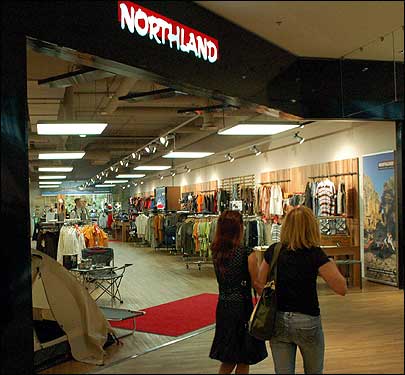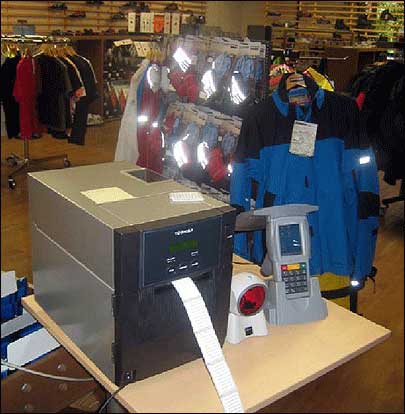Northland, an Austrian outdoor apparel and equipment retailer, has revealed that it is currently testing a dual-function tag that enables the company not only to manage its inventory but also to deter theft. The tag, which UPM Raflatac unveiled in 2007, functions as a passive EPC Gen 2 UHF RFID tag, as well as a security tag that alerts retail store employees that an item is being stolen—much like the RF-based electronic article surveillance (EAS) tags widely used by retailers today (see Raflatac Releases RFID Tags With Built-In EAS).
The EAS function is made possible by an extra bit of memory within the tag’s Ucode G2XL RFID chip, supplied by NXP Semiconductors. That extra bit can be toggled between 1 and 0, to indicate whether or not an item to which it is attached has been purchased. Based on the reading of this bit, the software controlling the interrogators will issue an alarm when unsold merchandise is detected moving through a store’s exit.

The creation of this toggle bit, however, is only part of the EAS function. In 2007, Rainer Lutz, NXP Semiconductors’ marketing manager, told RFID Journal that the other vital element to making the tags work as a security device would be an RFID reader that could generate a very defined, narrow read zone along a retail store’s exit, to ensure that only unpurchased items being brought out of the store would trigger an alarm, and not merchandise on display near the exit. To meet this goal, engineers at the NXP RFID Reference Design Center—a testing and systems development laboratory near Graz, Austria—have developed a reader antenna configuration that creates a thin, electronic curtain along a store portal.
Lutz says the Northland test site, a newly erected store in Graz, is employing this antenna configuration in conjunction with a ThingMagic EPC Gen 2 interrogator. RFID middleware provider RF-iT has helped deploy the test and is providing its You-R Open RFID software, used both to conduct product inventory and to alert the store’s staff if an item is stolen.
The tag contains a UPM Raflatac EPC Gen 2 Web inlay, which utilizes an antenna design optimized for omnidirectional reading, as well as for use in environments with dense tag populations, which make it well suited for retail applications.
For the technology test, Lutz says, roughly 1,600 products are tagged. This represents virtually all of the merchandise within the store, he explains, except for small, low-priced high-volume accessories. As each new shipment of goods is received into inventory, workers use a Toshiba RFID label printer-encoder to encode Electronic Product Codes (EPCs) to labels that are then attached to the items’ hangtags. The toggle bit in each inlay is set to 1, indicating that the item, associated with that label’s EPC in the You-R Open software, has not been purchased.
At the point of sale, each tagged item being purchased is placed on an RFID reader antenna customized to fit into the sales counter. A salesperson conducts the transaction in the normal fashion, but at the end of the sale, an alert box appears on the sales terminal screen. The box displays a list of items the antenna is reading. If this list matches the purchases that have just been rung up, the salesperson approves the list, generating a command in the RF-iT software that directs the RFID reader to switch each tag’s toggle bit to 0. Thus, when the customer walks out of the store, no alarm is triggered. If, however, that person has slipped a product into his jacket or bag in an effort to steal it, the system issues an alert.
Although the RF-iT software can be configured to present an audio or visual alarm, Northland has decided not to use such an option. Instead, the point-of-sale terminal displays a text alert listing which unpaid items were detected, along with detailed descriptions of each. The salesperson then calls the security company that provides guards to patrol the shopping mall in which the store is located. The company dispatches an order to the nearest security guard to search for someone matching the description of the suspect provided by the sales staff. If the suspect is located, the guard can then ask the store’s salespeople to name the items believed to have been stolen. (Northland instructs its staff not to confront possible thieves, out of concern for employee safety.)

The ability to know the exact items that were taken, and when they left the store, is one of two benefits Northland hopes to exploit, should it opt to roll out the EAS tags across all of its stores. Even if stolen items are not recovered, the retailer can ensure that its inventory is updated to compensate for the loss. The other main benefit the company sees in the system, says Otto Url, the Northland employee responsible for the RFID project, is the cost-savings from combining inventory and security functions on a single tag, rather than attaching separate RFID and EAS tags to each item.
“Northland is preparing to build a case for RFID throughout the company,” Lutz says, and if the current proof-of-technology tests prove successful, the retailer plans to move the tagging of apparel to the point of manufacturing. The Graz store test began roughly four weeks ago, and is slated to continue until mid-September, at which point the retailer plans to evaluate the results. No data on whether the system has impacted the store’s rate of theft is yet available, though Lutz says that by using handheld interrogators to read the RFID tags on the products, the store is reducing the amount of time required to take an inventory count by 20 percent.
In addition, RF-iT is presently working with a number of other retailers that are testing the use of dual-function RFID tags for item-level tracking and anti-theft applications.

